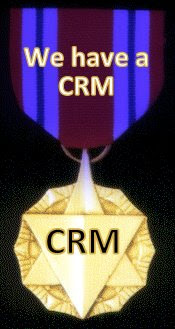 Dears,
Dears,According to figures from Gartner annual sales of CRM software exploded from $762 million in 1997 to $20 billion in 2010—nearly a 20+-fold increase in just a decade. To be fair, the methodology for gauging the size of the marketplace has always varied widely, and continues to do so today. But there’s little debate about CRM’s ongoing growth streak, a run that shows little sign of abating any time soon.
Is there any company today that doesn’t have at least some form of CRM? You’d be surprised: The percentage of firms that have implemented CRM may have increased from 53 percent in 2003 to 75 percent in 2010, but that means that, even now—as CRM has come to be seen as table stakes, as a must-have—a quarter of all companies are still muddling along without.
As with any enterprise initiative, CRM still requires a compelling business case in order to get the nod, especially in the midst of a difficult economic climate. Startling as it may seem to those who have seen its benefits, CRM often loses the budgetary battle to other projects that promise a better return on investment.
Cost remains an issue, of course—but one that’s faded and continues to fade fast. The expensive start-up price of an on-premises solution is now frequently supplanted by the relatively inexpensive subscription rates of CRM delivered via the software-as-a-service (SaaS) business model. (You may know it better as “on-demand computing,” or its newer tag, “cloud computing.”) .85 percent of all CRM systems in 2003 were on-premises solutions; just 15 percent were SaaS. Fast-forward to 2010, and SaaS has become the predominant method of accessing CRM, now claiming 53 percent of all deployments.
Need a sure sign of how SaaS has forever altered the CRM landscape? You need only cast an eye at SaaS pioneer Salesforce.com. The company accelerated from annual revenue of zero in its fiscal year 2000 to $1.3 billion in its fiscal year 2010, its branding also shifted, from sales force automation to CRM to on-demand computing to cloud computing. The transformation of CRM itself can be said to have followed a parallel path. The client-server era’s basic sales tracking and customer care gave way to Web-based CRM at the turn of the century, which led to the cloud-based CRM applications and services of today.
Some vital statistics for you
Annual Sales of CRM Software:
1997—$762 million
2010—$20 billion
Percentage of Firms That Have Implemented CRM
2003—53%
2010—75%
Mix of CRM Systems in Place
2003—85% On Premises vs. 15% SaaS
2010—47% On Premises vs. 53% SaaS
Fiscal Full-Year Revenue for Software-as-a-Service CRM Pioneer Salesforce.com
2000—$0
2010—$1.3 billion
CRM Failure Rate
2001—50%
2002—70%
2005—18%
2006—31%
2007—56%
2009 —47%
As a maturing market, however, CRM now has the benefit of its own history, a track record to compare against, and recommended practices that can at least help tilt the scales toward success.
CRM is no longer the Four Letter Word and the Badge is worth Wearing
Some words just leave a bad taste, and the notion of washing your mouth out with soap simply isn’t going to do the trick. Some companies had been so burned by failed CRM implementations that they had grown convinced that the technology was only capable of delivering more harm than help. Unfulfilled promise and hundreds of thousands—if not millions—of dollars frittered away on flawed initiatives.
A couple of factors contributed to CRM’s unfortunate reputation, Companies hadn’t put into place what their business objectives were, other than some very high-level vision of ‘keeping in touch with the customer. CRM adopters in the ’90s and early ’00s. “They didn’t realize that the implementations required a fair amount of professional services, organizational change, and business process reorientation to be successful.”
Ironically, for a technology built on the shoulders of sales force automation (SFA); CRM wasn’t seen in a good light by salespeople, a perception particularly true with the offerings from the era’s frontrunners, Siebel Systems and SAP. People were using probably 15 percent of the functionality in 80 percent of the implementations,” he says. It boiled down to the sense of the solution—it was a glorified contact manager with maybe some forecasting, as well. If done right, SFA can be an effective forecasting tool and [can] certainly help consolidate information. “But you also have to give salespeople something they want to use, something that makes their job more efficient so that they don’t mind spending the extra time inputting data.”
Things started to change, however, with the emergence of software-as-a-service (SaaS) and on-demand offerings; mobile computing; and the application of data and business intelligence and analytics. There’s been a democratization of analytics in the last 10 years,” .Refreshed user interfaces and dashboards enable salespeople to customize their own CRM portals for analytics. Breakthroughs in mobile computing have also altered the CRM landscape, with users accessing CRM on their mobile phones, changing the nature of sales and service in the field.
Now you can build systems that are much more end-to-end for your business. Not only that, but companies can connect with like-minded individuals on the social Web. Ten years ago, before customer communities and user groups, People want to know they aren’t alone. If you’re doing an 8,000-seat deployment, you want to connect people up at the same scale.” Today, that level of connectivity can be achieved simply by logging on to Twitter.
The recession also renewed interest in customer retention; CRM became, for many, a crutch during a time of uncertainty. CRM, a badge that industry members can wear with pride. With advances such as SaaS, mobile computing, analytics for the business user, and social CRM and service side of CRM too is enjoying brighter days, with improved interfaces and real-time information brought to an integrated agent desktop.
CRM is fun again and enjoy your CRM moments.
Your Partner and Companion
Dinesh Chandrasekar DC*

No comments:
Post a Comment